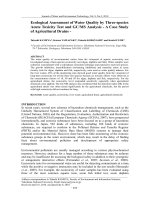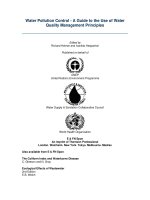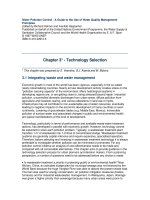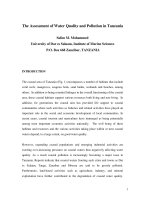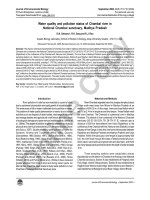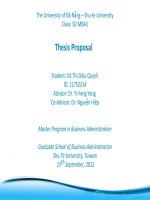The Assessment of Water Quality and Pollution in Tanzania pptx
Bạn đang xem bản rút gọn của tài liệu. Xem và tải ngay bản đầy đủ của tài liệu tại đây (73.07 KB, 18 trang )
The Assessment of Water Quality and Pollution in Tanzania
Salim M. Mohammed
University of Dar es Salaam, Institute of Marine Sciences
P.O. Box 668 Zanzibar, TANZANIA
INTRODUCTION
The coastal area of Tanzania (Fig. 1) encompasses a number of habitats that include
coral reefs, mangroves, seagrass beds, sand banks, wetlands and beaches, among
others. In addition to being essential linkages in the overall functioning of the coastal
area, these coastal habitats support various resources both living and non-living. In
addition, for generations the coastal area has provided life support to coastal
communities where such activities as fisheries and related activities have played an
important role in the social and economic development of local communities. In
recent years, coastal tourism and mariculture have immerged as being potentially
among most important economic activities nationally. The well being of these
habitats and resources and the various activities taking place within or near coastal
waters depend, to a large extent, on good water quality.
However, expanding coastal populations and emerging industrial activities are
exerting ever-increasing pressures on coastal waters thus negatively affecting water
quality. As a result coastal pollution is increasingly becoming a major issue in
Tanzania. Reports indicate that coastal waters fronting such cities and towns as Dar
es Salaam, Tanga, Zanzibar and Mtwara are said to be grossly polluted.
Furthermore, land-based activities such as agriculture, industry, and mineral
exploitation have further contributed to the degradation of coastal water quality.
1
This report gives a summary of the available information about water quality and
pollution in Tanzania.
Water quality research in Tanzania
Research in pollution and water quality does not have a long history in Tanzania.
During a literature search preceding this synthesis, the earliest records found on this
aspect were from the early 1970s. For example, a 1971 report by the Danish Isotope
Center gives results of a feasibility study that assessed receiving water supply for Dar
es Salaam. Another study by Steinbach (1974) reported on the relationship between
industry and environment in the Msimbazi Valley drainage area. Ngoile et al (1978)
discussed some aspects of aquatic pollution in Tanzania. These studies were
followed, in the 1980s, by a number of investigations on different aspects of the
environment (e.g. Shanmungam, 1981; Shanmungam, 1983;UNIDO/UNEP, 1982).
Then beginning the early 1990s, there was an upsurge of publications on the topic
making this period by far the most productive in terms of studies on pollution and
water quality.
In Dar es Salaam, Kondoro (1997) assessed heavy metal (Pb, Cd, Zn, Cu, Cr)
distribution along Msimbazi River. Mwandya (1996) determined the concentrations
of heavy metals Pb and Cd in the soft tissues of Saccostrea cucullata in Ocean Road
beach and Msimbazi Creek. Other studies in include that of Wekwe et al (1989) who
assessed heavy metal content of several species of algae along the coast of Dar es
Salaam. Heavy metal pollution was also studied by Machiwa (1992) who assessed
anthropogenic input of Fe, Mn, Zn, Pb, Cr, Cd and organic carbon in Dar es Salaam
coastal sediments. Machiwa (1992) also investigated the possibility of the
occurrence of toxic materials (PCBs) and organic carbon and pathogenic microbes in
the marine sediments off Dar es Salaam. In other studies, Lyantagaye (1996)
invested the distribution of dissolved inorganic nutrients and dissolved oxygen in
Mzinga Creek and Ocean Road coastal waters while Mamboya (1996) investigated
2
wet and dry season variations of those parameters in Mbezi Creek. Mlay (1994)
assessed the interrelationship between environmental conditions and algal abundance
and Chlorophyll a concentrations in the University of Dar es Salaam wastewater
sedimentation ponds.
Several pollution assessment studies have been carried out in Zanzibar, mostly in the
waters fronting the Stone Town in the Zanzibar Municipality. Among the earliest
such studies is that carried out by Van Bruggen (1990) who measured water
temperature, DO, conductivity, pH, BOD, COD, heavy metals and faecal and total
coliforms. This study was commissioned by the Zanzibar Department of
Environment to facilitate the formulation of the Zanzibar Environmental Policy.
This study was followed by that of Mohammed (1990), who investigated pollution by
industry and other users of chemicals in Zanzibar. Mohammed et al (1993) looked at
the impact of pollutants (nutrients and coliforms) on the reefs fronting the Zanzibar
Town. Another study was by Walvoord (1993) who measured baseline
concentrations of dissolved nutrients, BOD, salinity and dissolved oxygen at 14 sites
in the same area. Anderson (1994) carried out a two-week measurement of pH,
dissolved nutrients, temperature, salinity, turbidity and dissolved oxygen at the
Zanzibar harbour. Johnstone and Suleiman (1997) measured nutrient concentrations
near the islets of Bawe and Chapwani (off the Stone Town). They also examined
nutrient dynamics and community response to nutrient loading. Mmochi and Francis
(1999) undertook a long term monitoring of water quality also in the Stone Town
area of Zanzibar.
Studies carried out outside the Zanzibar Town area include those by Kastner (1996)
who compared nitrification rates in an unpolluted environments (a mangrove stand at
Chwaka Bay and a beach at Fuji Beach) and a polluted beach (Stone Town,
Zanzibar). Mmochi (1997, 1998) studied pesticide and nutrient pollution of ground
water in the Chwaka Bay, Paje, Fumba and Mahonda-Makoba basins in Zanzibar.
Mmochi et al (1999) assessed the quality and effects of groundwater outflow on the
3
near shore biota of Paje, Fumba and Makoba in Zanzibar. At Maruhubi, Machiwa
(1999) measured lateral fluxes of organic carbon.
Many review studies have been carried out to assess the pollution problem especially
in the Dar es Salaam area. Uronu (1995) analysed the development of the sewerage
system in Dar es Salaam, from its construction in 1948 through its different extension
phases in the 1970s. The report also assessed domestic sources of pollution along the
coast of Dar es Salaam. Another review of the development of the sewerage system
of Dar es Salaam was done by Martinez (1998).
Other reviews include that of Bryceson et al (1990) who assessed the state of the
marine environment in the East African Region, including Tanzania. In another
study, Bryceson (1981b) reviewed some problems of marine conservation with
particular reference to Tanzania. A comprehensive review of the sources of
pollution in Tanzania mainland was conducted by Mgana and Mahongo (1997), who
quantified all major human activities that contributed to pollution of the marine
environment. A similar kind of review was carried out in Zanzibar by Mohammed
(1997) who investigated land-based sources of pollution affecting coastal, marine and
associated freshwater environments on the islands. Other reports from Dar es Salaam
are those by Bwathondi et al (1991) who compiled all available data at that time on
pollution of the Msimbazi River and advised on the need for a comprehensive
multidisciplinary research. Mashauri and Mayo (1989) discussed the potential
impact of discharging raw sewage into the Indian Ocean. In Tanga, Shilungushela
(1993) made an inventory of destructive activities to the marine and freshwater
bodies in the Tanga region.
Most of the information on water quality and pollution in Tanzania comes from areas
in or around major towns and cities. Consequently, Dar es Salaam, Tanga, and
Zanzibar received the most coverage. In this regard, geographical coverage of water
quality studies in Tanzania can be best termed as very poor. It can argued that the
areas most affected by pollution are those that are located next to these densely
4
populated towns and cities, hence the studies. This is truly the case as has been
shown by these studies. However, even in Dar es Salaam, Tanga, and Zanzibar, not
all areas have been covered by these studies, both in terms of subject and geographic
coverage. In Dar es Salaam, most studies have concentrated in the Msimbazi River
and Creek and the harbour area, at the expense of other areas. The same can be said
of Zanzibar and Tanga. In Zanzibar, the majority of water quality studies were
carried out in the waters fronting the Stone Town in the Zanzibar Municipality.
These include both baseline and monitoring studies. In Tanga, the studies carried
out in that municipality targeted specific areas that are recipients of either municipal
wastes or wastes from the local industrial facilities including a fertiliser factory (e.g.
Munisi, 1998). However, a 1993 study by Shilungushela in Tanga looked at among
other things, pollution emanating from the agricultural sector in the area. Hardly any
other study has ha been conducted outside these areas. It is obvious then that there is
a need to broaden the geographic coverage of water quality studies to other parts of
Tanzania where virtually no information on this subject exists.
The subject area most covered by water quality studies in Tanzania is pollution
emanating from sewage waste. This reflects the previously mentioned fact that most
studies have been concentrated near major population centres and the nation’s
concern on sewage pollution. Fewer studies have looked at other sources of water
quality degradation and their impacts on the natural environment and on human
health. Studies have mainly focussed on nutrient loads and distribution, BOD and
coliforms levels and other indicators of sewage pollution. Studies on heavy metal
pollution and that emanating from organic compounds and agrochemicals are few
and far between. Among the few studies of this kind include a study by Mmochi and
Mberek (1998) who looked at trends in pesticide use and toxicity in Tanzania and
those by Machiwa (1992a,b) which assessed pollution by heavy metals and other
toxic material. Both Tanga and Dar es Salaam have relatively high concentrations of
manufacturing concerns. Since few industries in Tanzania treat their wastes before
they are discharged into the environment, it is obvious that these industries contribute
significantly in the pollution loads. Given the current pace of industrial development
5
in the country and the fact that only few studies on industrial pollution have been
done, it is important that more studies should be carried out to generate both baseline
information as well as to follow trends on the impact of these wastes on the water
quality.
The majority of the studies carried out so far looked at pollution loads per se and
noticeably few have examined the impact of pollutants on the natural or social
environments. Some of these studies are mentioned here. The first one was
conducted in Tanga where Munisi (1998) investigated the effects of waste discharges
from a fertiliser factory on intertidal floral communities. Other studies were carried
out in the waters fronting the Stone Town of Zanzibar where Bjork, et al. (1995)
observed a reduction in coralline algal caused by sewage pollution from the
municipality. Johnstone and Suleiman (1998) reported increased community
metabolism and gross production in the same area which they attributed to excess
loading of nutrients through sewage discharge from the municipality. Machiwa
(1999) examined the effects of sewage dumping on the levels and rate of
mineralisation of organic carbon in sediments of a partly polluted mangrove stand in
Maruhubi in Zanzibar. Kangwe (1999) studied the effects of mercury, lead and
cadmium on calcification rates of the reefs building calcareous algae Amphipora
tribulis. Other studies include that which looked at the impact of pollution on
plankton biomass and composition at Kunduchi and the harbour area of Dar es
Salaam (Lugenda, 1998) and port development in Tanzania and their impacts on
marine environment (Shanmungam, 1981). Bryceson (1982) assessed the impact of
effluent (domestic, industrial) disposal on the ecology of Dar es Salaam coastal
habitats. Chande (1994) identified and assessed the magnitude of activities that had
an impact on the marine environment. Shunula and Ngoile (1989) assessed the
consequences of human activities on the marine environment of Zanzibar.
The State of Water Quality in Tanzania
6
Several studies have shown that in general the coastal waters in many parts of Tanzania
are in a relatively pristine condition. The exception is coastal areas bordering major tows
and cities that are recipients of untreated municipal and industrial wastes and those areas
receiving agricultural wastes. These include the main coastal towns of Dar es Salaam,
Tanga, Mtwara and Zanzibar. In Zanzibar, faecal coliform and total coliform levels of
up to 70/100 ml and numerous thousands per ml of seawater respectively have been
reported in the waters fronting the Zanzibar Municipality (Mohammed, 1997). Nutrient
levels are also higher than normal for tropical seawaters indicating anthropogenic inputs.
Concentrations of nitrate of up to 7.8 µ-at N/l phosphate of 4.0 µ-at N/l (Anderson, 1994)
and dissolved ammonium levels of up to 28.6 µ-at N/l (Mohammed and Kyewalyanga,
2001) have been reported. Sewage pollution has been cited as principally responsible for
increased cases of waterborne diseases on the islands. These include diarrhoea, gastro
enteritis, cholera and dysentery.
Likewise, it has been reported that there is a proliferation of macroalgae in Tanga coastal
waters due to excess nutrient loadings from discharges from a fertiliser factory and from
the municipality (Munisi, 1999). Coastal pollution in Tanga is also attributed to
discharge of effluents from sisal decorticating plants in the area. Up to twenty plants
discharge their wastes onto the coast via the Pangani, Sigi, Mruazi/Mnyuzi and
Mkurumzi Rivers (Shilungushela, 1993) some of which are heavily polluted (See Table 1
below).
In Dar es Salaam, domestic waste is the most serious source of pollution. The waste
generated by 15% of the city residents who are connected to the sewer system is
discharged into the sea untreated. As a result, the coastal waters, especially in vicinity of
the Dar es Salaam harbour, are heavily polluted. Discharge of untreated sewage in Dar es
Salaam has resulted in high faecal and total coliform levels in the same areas. The
situation is made worse by a broken sewer pipe which discharges untreated sewage on
sandy-mud flats near the harbour which is said to threaten invertebrates and fish
(Bryceson, 1981, Bryceson et al, 1990). It has also been reported that chlorinated organic
compounds are at alarming levels in the harbour areas as are heavy metals, Pb, Zn and Cu
7
(Machiwa, 1992). The harbour area also suffers from oil pollution from the refinery at
Kigamboni, and industrial wastes from Keko, Chang’ombe, Kurasini, Mtoni and Temeke.
These discharge heavy metal, pesticide, organic, and paint wastes into the nearby area
(Bryceson, 1983).
Msimbazi River and Creek are also among the most polluted water bodies in Dar es
Salaam. The river and creek receives large quantities of untreated domestic wastes
from the city’s residents in addition to industrial wastes from various industries. The
river and creek receive such pollutants as dyes and paint wastes and strong alkalis
(from textile factories), oil and tars, (from vehicle depots and power stations),
organic wastes (from breweries and meat plants). Other industrial and agricultural
chemicals that pollute the river and creek include heavy metals, PCBs, cyanides,
pesticides, and detergents (Bryceson, et al, 1982). Table 2 and 3 give pollution loads
in surface and ground water sources respectively in Dar es Salaam.
Other coastal areas of Tanzania outside the major cities and townships though free
from domestic wastes do suffer from input of agricultural wastes, including
pesticides and fertilisers, via rivers and streams. Most major rivers in the country
drain agricultural lands and deposit their waste loads on the coast. Unfortunately,
this area of concern has not received sufficient attention in the literature. River
discharges on coastal areas also carry with them industrial wastes. A case in point is
Kilombero River, which transports wastes from the Mufindi Pulp and Paper Mill
from the hinterland to the coast (Bryceson et al, 1990).
Vast amounts of sediment enter the coastal waters annually via the nation’s river
networks. Such inputs can be a result of natural events such as storm events and
rains in upland areas, poor agricultural practices have been known to play a leading
role in water quality degradation due to sedimentation (Bryceson, 1981). A direct
consequence of sedimentation is the smothering of corals and other organisms lying
on its path. Sedimentation also has a detrimental effect on social and economic
potential of coastal waters causing the reduction of aesthetic value of the water thus
8
making it less attractive for such activities as tourism as well as for general
recreational activities.
Recommendations
Not a single city or town in Tanzania has sewage treatment facilities. Invariably,
waste from these cities/towns is discharged untreated into the environment, mainly
into coastal waters via local sewer networks and rivers and through. In most cities
and towns sewer networks are either nonexistent, inadequate or in an advanced state
of disrepair. For example only about 15% of Dar es Salaam residents are connected
to the city sewer network which was build in the late 1950's. The city has eight
oxidation ponds, of which only four are in operation (University of Dar-es-Salaam,
Kurasini, Mikocheni and Vingunguti). Over 80% of the households in the city use
pit latrines and septic tanks. These frequently overflow, especially during the rains,
contaminating water sources thus increasing health risks in the neighbourhoods.
The Zanzibar sewerage system which dates back to the 1920s serves only about 18%
of the population. Like in Dar es Salaam, waste from the town’s residents is dumped
untreated in the nearby coastal waters. The same situation prevails in other towns
along the coast.
For the long-term sustainability of the coastal zone ant its resources, it is important to
develop better facilities including treatment plants. However, given the potentially
huge investment requirements for secondary or tertiary waste treatment, it is
recommended that there should be installed at least primary waste treatment facilities
in the major cities to facilitate initial waste treatment before discharge. Tourist hotels
and industrial plants should have their own onsite treatment facilities to reduce waste
loads in the public sewer networks as well as avoid haphazard waste discharge.
The promotion of local awareness is key to the effective management of pollution and the
health risk associated with the problem. For example, there should be formulated
guidelines on the design and construction of wells and pit latrines with the view to reduce
9
pollution in peri-urban areas where these facilities are commonly used (Chaggu, 1993).
The public should be advised on the health risks associated with using water from
shallow hand-dug wells especially those facing the risk of contamination from pit latrines
and should be discouraged from using such facilities. A monitoring program to study the
fluctuation of ground water levels and quality should be initiated in areas where shallow
wells and pit latrines are commonly used with the view to help in pollution and health
risk management. The public should also be made aware of the health risks associated
with seawater pollution such as the dangers of eating contaminated fish and shellfish and
swimming in sewage contaminated waters.
There is a paucity of information on water quality for a large part of the coast of
Tanzania. Such information is essential in setting up management strategies. To start
with, priority should be given to filling up gaps in areas where there little or no data
available before embarking on long term studies. Consequently short-term studies
should take priority over long term monitoring programs. However, this should be
decided on a case by case basis, as there are areas that urgently require monitoring of
both pollution inputs and its effects on natural environment.
Pollution in Tanzania has yet to reach alarming levels. However, given the
continuing population pressure and industrialisation in the country as well as the
presence of some hotspots along the coast, necessary steps need to be taken to
preclude further deterioration of water quality in the country.
10
.
REFERENCES
1. Anderson, B., 1994: An environmental monitoring approach to sewage pollution
issues along the west coast of Zanzibar. SIT Marine Ecology Tanzania. 31p.
2. Bjork, M., S.M. Mohammed, Bjorklund, M., and A. Semesi, 1995: Corraline
algae, important coral reef builders threatened by pollution. Ambio, 24 (7-8): 502-
503.
3. Bjork, M., S.M. Mohammed, M. Bjorklund, M., and I. Naaslund, 1996:
Distribution of coral associated algae at four locations near Zanzibar Town,
Tanzania. In (M. Bjork, A.K. Semesi, M. Pedersen and B. Bergman, eds.)
Current Trends in Marine Botanical Research in the East African Region.
Proceedings of the Symposium on the Biology of Microalgae, Macroalgae and
Seagrasses in the Western Indian Ocean. 3-10 December, 1995. University of
Mauritius, pp. 347-357.
4. Bryceson, I., 1983: Pollution of Dar es Salaam Coastal environments by
industrial and domestic effluents. In: Status and Problems of Marine Resources
Development in Tanzania. Recommendations and selected papers from the
workshop on “The Current State and Development of Marine Sciences in
Tanzania.” Zanzibar, 2-8 April, p. 32-41.
5. Bryceson, I., 1981: A review of some problems of tropical marine conservation
with particular reference to the Tanzanian coast. Biological Conservation, 20:
163-171.
6. Bryceson, I., 1982: Pollution of Dar es Salaam coastal environments by industrial
and domestic effluents. In Proceedings of the Workshop on the Current State
and Development of Marine Sciences in Tanzania. Institute of Marine Sciences,
11
Zanzibar. 2-8 April, 1982, pp. 32-41. Bryceson, I., 1990: State of the marine
environment in the Eastern African Region. UNEP Regional Seas Reports and
Studies No. 113.
7. Bryceson, I., T.F. De Souza, I. Jehangeer, M.A.K. Ngoile, and P. Wynter, 1990:
State of the marine environment in the Eastern African region. UNEP Regional
Seas Reports and Studies No. 113.
8. Bwathondi, P.O.J., S.S. Nkotagu, and S. Mkuula, 1991: Pollution of the
Msimbazi valley. Report commissioned by National Environment Management
Council (NEMC), Dar es Salaam, 28p.
9. Chaggu, E.J., 1993: Ground water pollution Majumbasita, Tanzania. Final
Research Report. Ardhi Institute. 107p.
10. Chande, A. I., 1994: Inventory of destructive activities affecting the aquatic
environment: Mtwara region. National Environment Management Council, Dar
es Salaam, 38p.
11. Johnstone, R. and M. Suleiman, 1997: Some aspects of the interaction between
pollution and nutrient dynamics on coral reefs around Zanzibar. In (R.W.
Johnstone, J. Francis and C.A. Muhando (Eds.) Proceedings of the National
Conference on Coral Reefs. Zanzibar, 2-4 December, 1997. Pp. 45-50.
12. Kangwe, J.W., 1999: The effect of land based pollution on reef building
calcareous algae in the reefs near Zanzibar Town. MSc Thesis. University of Dar
es Salaam. 97p
13. Kastner, T., 1996: Measurements of nitrification rates in three coastal ecosystems
in Zanzibar. SIT Marine Ecology Tanzania.25p.
12
14. Kondoro, J.W.A., 1997: Dispersion of heavy metals along Msimbazi River basin
in Dar es Salaam, Tanzania. Tanzania Journal of Science, 23: 1-10.
15. Lugenda C, 1995: The effect of pollution on the phytoplankton biomass and
composition. A Third Year Student Project. Department of Zoology and Marine
Biology, University of Dar es Salaam.
16. Lyantagaye, S.L, 1996: Nutrients and dissolved oxygen distribution in Mzinga
Creek and Ocean Road beach. A Third Year Student Project. Department of
Zoology and Marine Biology, University of Dar es Salaam. 34p.
17. Machiwa, J., 1999: Distribution and remineralisation of organic carbon in
sediments of a mangrove stand partly contaminated with sewage waste. Ambio
27:740-744.
18. Machiwa, J.F., 1992a: Anthropogenic pollution in the Dar es Salaam Harbour
area, Tanzania. Marine Pollution Bulletin, 24 (11): 562-567.
19. Machiwa, John F., 1992b: Heavy metal content in coastal sediments off Dar es
Salaam, Tanzania. Environment International. 18: 409-415.
20. Mamboya, F.A., 1996: Seasonal variation of nutrients and dissolved oxygen in
Mbezi creek. A Third Year Student Project. Department of Zoology and Marine
Biology, University of Dar es Salaam. 18p.
21. Martinez, C., 1998: An assessment of the attempts to manage the
sewerage/sanitation system of a growing East African coastal city – Dar es
Salaam, Tanzania. University of Rhode Island, 18p.
22. Mashauri, D.A. and A. Mayo, 1989: The Environmental impact of industrial and
domestic wastewater in Dar es Salaam. In Symposium on Environmental
13
23. Mgana, S. and S. Mahongo, 1997: Land-based sources and activities affecting the
quality and uses of the marine, coastal and associated freshwater environment:
Tanzania Mainland. Report presented at the UNEP Regional Workshop, Institute
of Marine Sciences, Zanzibar. 6-9 October, 1997. 50p.
24. Mlay, E.H., 1994: Abundance of phytoplankton in relation to certain
environmental factors in the sewage ponds at the University of Dar es Salaam. A
Third Year Student Project. Department of Zoology and Marine Biology,
University of Dar es Salaam.
25. Mmochi, A.J. & R.S. Mberek, 1998: Trends in the types, amounts and toxicity of
pesticides used in Tanzania: Efforts to control pesticide pollution in Zanzibar.
Ambio, 27(8): 669-676.
26. Mmochi, A.J., 1997: Pesticide and nutrient pollution of the ground water outflow
to the nearshore water of Zanzibar Island, the case of Chwaka Bay, Paje, Fumba
and Makoba Bay. In: First Annual Progress Report of the INCO Project:
Anthropogenically induced changes in groundwater outflow and quality, and the
functioning of eastern African nearshore ecosystems (GROFLO) p117-122.
27. Mmochi, A.J., 1998: Pesticide and nutrient pollution of the ground water outflow
to the nearshore water of Zanzibar Island, the case of Chwaka Bay, Paje, Fumba
and Makoba Bay. In: Second Annual Progress Report of the INCO Project:
Anthropogenically induced changes in groundwater outflow and quality, and the
functioning of eastern African nearshore ecosystems (GROFLO) p54-56.
28. Mmochi, A.J. and J. Francis, 1999: Long term monitoring of water quality in
Zanzibar, Tanzania. Institute of Marine Sciences, Znzibar.31pp.
14
29. Mmochi, A.J., M.S. Mtolera, J.P. Shunula, and S.G.M. Ndaro, 1998: The quality
and effects of groundwater outflow on the nearshore biota in Zanzibar.
Unbublished report. 18pp.
30. Mohammed, S. M., 1997: Land based sources and activities affecting the coastal,
marine and associated freshwater environment along the coast of Zanzibar.
FAO.18p.
31. Mohammed, S.M., 1990: Pollution by industry and other users of chemicals.
Zanzibar Environmental Study Series, 2. Commission for Lands and
Environment, Zanzibar 33p.
32. Mohammed, S.M., 1997: Assessment of land based sources of pollution in
Zanzibar. Institute of Marine Sciences, Zanzibar. 12p.
33. Mohammed, S.M., 1997: Water quality assessment in the coastal waters fronting
the Stone Town, Zanzibar. Dorsch Consult, Zanzibar (Part 1-3).
34. Mohammed, S.M., A.S. Ngusaru, and O.U. Mwaipopo, 1993: Determination of
the effects of pollutants on coral reef areas around Zanzibar town. Report
submitted to National Environment management Council, Dar es Salaam.
35. Munisi, J.J., 1998: A comparative study of polluted and unpolluted intertidal
floral communities near Tanga Town. A report submitted for the fulfilment of the
forth term programme at the University of Dar es Salaam. Department of
Zoology and Marine Biology. 17pp.
36. Mwandya, A. W., 1996: Variability and morphometric relationships of lead and
cadmium in Saccostrea cuccullata and Pinctada marginitifera along the Dar es
Salaam coast. Third Year Student Project. Department of Zoology and Marine
Biology, University of Dar es Salaam. 31p.
15
37. Ngoile, M.A.K., A.E. Challe, and R.R. Mapunda, 1978: Aquatic pollution in
Tanzania. Paper presented at the Sixth FAO/SIDA Workshop on Aquatic Pollution
in Relation to the Protection of Living resources. Nairobi and Mombassa, Kenya.
12 June-22 July, 1978. Rome, FAO, Doc. FIR: tplr/78/inf. 19.
38. Shanmungam, A.T., 1981: Ports development in Tanzania and their impact on
marine environment. Paper presented to United Nations/East African Workshop
on Resources Policy and Management in Coastal/Marine Zones. October, 1981.
Tanzania Harbours Authority, Dar es Salaam, 15p.
39. Shanmungam, A.T., 1983: The control of oil pollution in Tanzania coast. In (J.R.
Mainoya, P.O.J. Bwathondi and H.B. Pratap, eds.) The Current State and
Development of Marine Sciences in Tanzania. Zanzibar, 2-8 April, 1982, pp. 45-
54.
40. Shilungushela, J.M.S., 1993: Inventory of destructive activities to the freshwater
bodies and the marine environment along the Tanga region coastal area. Report
commissioned by National Environment Management Council (NEMC), Dar es
Salaam, 57p.
41. Shunula, J.P. and M.A.K. Ngoile, 1989: Consequences of human activities on the
marine environment of Zanzibar. In (M.R. Khan and H.J. Gizjen, eds.)
Environmental Pollution and its Management in Eastern Africa. University of
Dar es Salaam, Dar es Salaam. 11-15 September, 1989, pp. 134-151.
42. Steinbach, A.B., 1974: Industry and environment in the Msimbazi valley
drainage, Dar es Salaam. East African Social Environment course, University of
Dar es Salaam, 12p.
16
43. UNIDO/UNEP, 1982: Industrial sources of marine and coastal pollution in the
East African region. UNEP Regional Seas Reports and Studies No. 41.
44. Uronu, W.E.M, 1995: Sewerage Issues in the Dar es Salaam area. In:
Proceedings of the National Workshop on Integrated Coastal Zone Management
in Tanzania. May 8-12. The World Bank Land, Water, and Natural Habitats
Division Environmental Department.
45. Van Bruggen, J.J., 1990: A preliminary study on environmental pollution on
Zanzibar. Zanzibar Environmental Study Series No. 6.
46. Walvood, M.A., 1993: Environmental Impact Study of sewage pollution along
the west coast of Zanzibar Town. SIT. 39p.
47. Wekwe, W.W., O. C. Othman, and M.R. Khan, 1989: Seaweeds as heavy metal
pollution indicators. In (M.R. Khan and H.J. Gijzan, eds.) Environmental
Pollution and its Management in Eastern Africa. University of Dar es Salaam,
Dar es Salaam, pp. 241-248.
17
18
